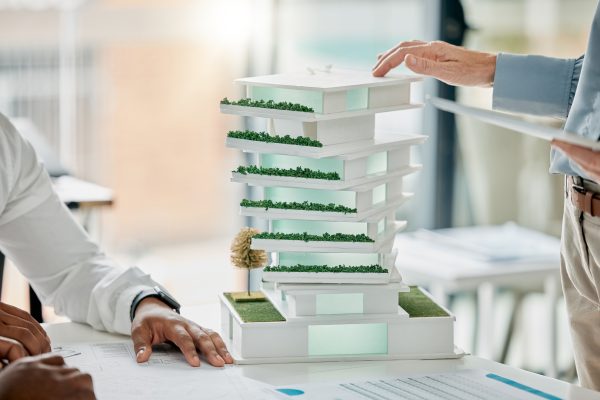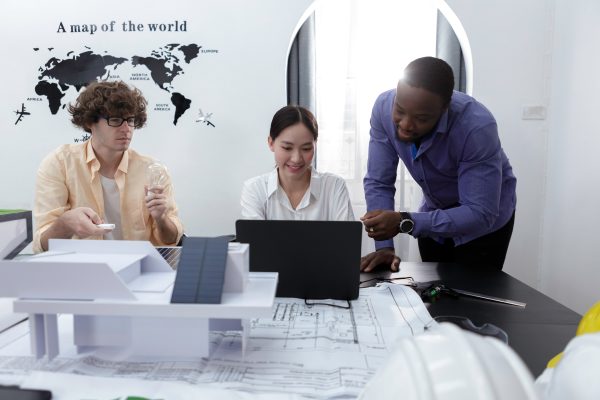In architecture, sustainability is no longer just a buzzword—it’s a necessity. In fact, a new study from Dodge Data & Analytics indicates that the design and construction industry prioritizes green building. As the world grapples with environmental challenges, the architectural industry is pivoting towards sustainable practices, driven by a combination of regulatory pressures, client demand, and the inherent benefits of green design. But beyond the ethical and environmental imperatives, promoting sustainable architectural practices offers tangible financial rewards. This blog explores how advocating for sustainability can attract and retain clients, ultimately boosting return on investment (ROI) for architecture firms.
The Return on Investment in Promoting Sustainable Architectural Practices

The Growing Demand for Sustainable Architectural Practices
-
Client Expectations and Market Trends
Today’s clients, whether residential, commercial, or institutional, are increasingly aware of environmental issues. They seek buildings that not only meet their functional and aesthetic needs but also reflect their commitment to sustainability. According to Statista, as of April 2024, the total area of buildings in the United States that have achieved a gold-level certification under the LEED (Leadership in Energy and Environmental Design) program amounts to over 3.7 billion square feet. This impressive figure underscores the growing marketability and value of green-certified buildings, highlighting the increasing demand for sustainable and energy-efficient design in the real estate market. Clients are willing to invest more in properties with lower operating costs, healthier environments, and a smaller carbon footprint.
BizForce’s architects excel in creating sustainable designs that align with these evolving client expectations. By choosing BizForce, clients gain access to innovative solutions that enhance the value and sustainability of their properties, making us the ideal partner for forward-thinking architectural projects.
-
Regulatory and Incentive Landscape
Governments worldwide are implementing stringent regulations to combat climate change. In many regions, building codes now require certain sustainability standards. Additionally, there are numerous incentives, such as tax rebates and grants, for green building practices. Firms that stay ahead of these regulations not only avoid potential penalties but also benefit from financial incentives, making sustainable projects more attractive from an ROI perspective.
Attracting Clients Through Sustainable Architectural Practices
-
Differentiation in a Competitive Market
In a saturated market, differentiation is key. By promoting sustainable practices, architecture firms can distinguish themselves as leaders in eco-friendly design. This unique selling proposition (USP) can be a decisive factor for clients who prioritize sustainability. Showcasing a portfolio rich in sustainable projects demonstrates a firm’s expertise and commitment to green building, attracting clients who value environmental responsibility.
-
Enhanced Marketing and Public Relations
Sustainability is a powerful marketing tool. Firms that actively promote their green initiatives often garner positive media attention. Awards, certifications, and participation in sustainability programs can be highlighted in marketing materials, enhancing the firm’s reputation. Case studies, blog posts, and social media campaigns focused on sustainable projects can engage potential clients and stakeholders, building a brand synonymous with innovation and responsibility.
Retaining Clients with Sustainability
-
Long-Term Cost Savings
One of the most compelling arguments for sustainable architectural practices is the promise of long-term cost savings. Energy-efficient buildings reduce utility bills through lower energy and water consumption. Sustainable materials often have longer lifespans, reducing maintenance costs. When clients experience these savings, they are more likely to continue working with the firm that delivered such value. This loyalty translates to repeat business and referrals, both critical components of sustained ROI.
-
Health and Well-Being Benefits
Sustainable buildings often feature improved indoor air quality, natural lighting, and non-toxic materials, contributing to the well-being of occupants. For commercial clients, this can mean higher employee productivity, lower absenteeism, and improved overall satisfaction. Residential clients benefit from healthier living spaces. These positive outcomes enhance client satisfaction, fostering long-term relationships and positive word-of-mouth, further boosting the firm’s ROI.
Financial Impact of Sustainable Architecture

-
Increased Property Values
Properties designed with sustainable architectural practices typically enjoy higher resale values. Studies have shown that green-certified buildings can command a premium in the real estate market. For developers and investors, this translates to higher returns on investment, making them more inclined to engage firms that specialize in sustainable design. This increased demand can lead to more projects and higher revenue for architecture firms.
-
Operational Efficiency
Promoting and implementing sustainable architectural practices can lead to greater operational efficiency within the architecture firm itself. Streamlined processes, improved project management, and the integration of advanced technologies like Building Information Modeling (BIM) reduce costs and enhance productivity. Efficient operations mean more projects can be handled simultaneously, increasing overall profitability.
Sustainable Architectural Practices: Future Trends
Integration of Smart Technologies
The future of sustainable architecture lies in the integration of smart technologies, which promise to revolutionize the industry. Smart building systems that optimize energy use through real-time monitoring and automated adjustments can significantly reduce operational costs and environmental impact.
Advanced materials, such as self-healing concrete and energy-efficient glass, enhance sustainable architectural practices by increasing the lifespan and performance of buildings. Innovative construction techniques, like 3D printing, allow for precise, waste-reducing building practices and rapid prototyping, leading to more efficient use of resources. Firms that adopt and promote these cutting-edge technologies not only stay ahead of industry trends but also attract tech-savvy clients who value innovation and sustainability, thereby enhancing their return on investment (ROI) and securing a competitive edge in the market.
Sustainable Urban Planning
Urban areas are increasingly prioritizing sustainable architectural practices to manage the challenges of growing populations while minimizing environmental impact. Architecture firms that specialize in sustainable urban planning are at the forefront of this shift, designing cities that incorporate green spaces to improve air quality and provide recreational areas, efficient public transportation systems to reduce traffic congestion and emissions, and eco-friendly infrastructure that promotes energy efficiency and resilience.
These firms are well-positioned to capitalize on the surge in demand for sustainable urban development. Engaging in these large-scale projects not only aligns with global sustainability goals but also brings significant financial rewards due to the high value and scale of these initiatives, thereby boosting the overall return on investment (ROI) for architecture firms.
Conclusion
Promoting sustainable architectural practices is not just an ethical choice—it’s a strategic business decision that drives financial success. By differentiating themselves in the market, attracting and retaining clients, and capitalizing on the long-term benefits of green design, architecture firms can significantly enhance their ROI. As sustainability continues to be a critical factor in the industry, firms that lead the charge will enjoy a competitive edge and a prosperous future. The investment in sustainability today will yield substantial returns tomorrow, making it a cornerstone of modern architectural practice.
Partner with BizForce’s architects to take your projects to the next level. Contact us today to learn how we can help you achieve your sustainability goals while maximizing your return on investment. Click here.
